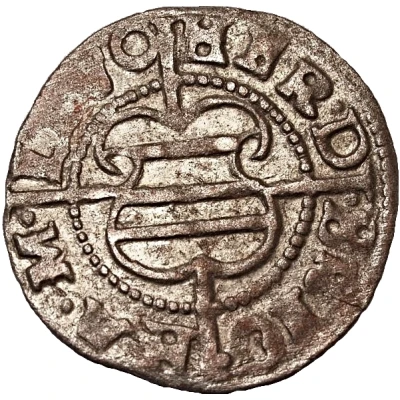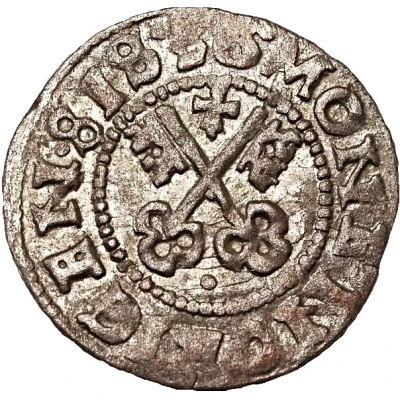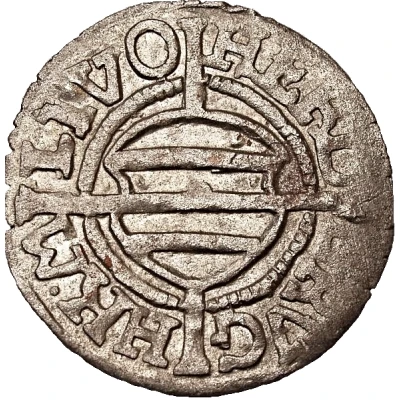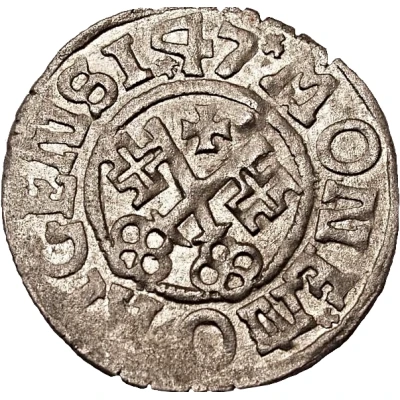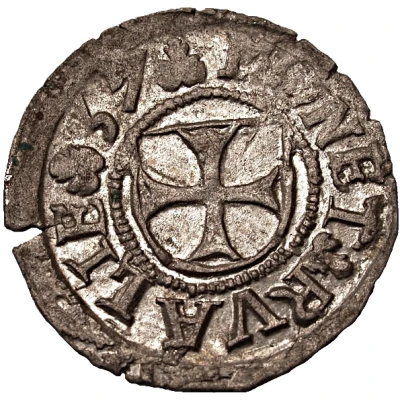
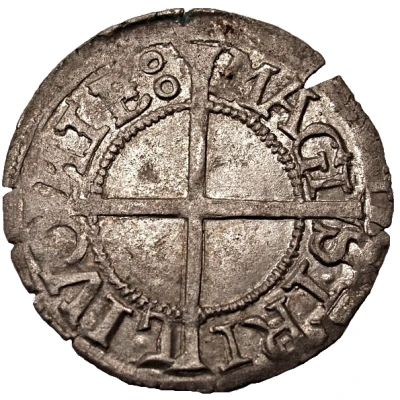

© Haljak Coin Auction
1 Schilling - Anonymous Reval
| Billon (.1875 silver) | 1.04 g | 18 mm |
| Issuer | Livonian Order (Livonian Confederation) |
|---|---|
| Master | Hermann von Brüggeneye (1535-1549) John of the Recke (Johann von der Recke) (1549-1551) Henry of Galen (1551-1557) William of Fürstenberg (1557-1559) |
| Type | Standard circulation coin |
| Years | 1537-1558 |
| Value | 1 Schilling |
| Currency | Schilling (1422-1561) |
| Composition | Billon (.1875 silver) |
| Weight | 1.04 g |
| Diameter | 18 mm |
| Thickness | 0.7 mm |
| Shape | Round |
| Orientation | Variable alignment ↺ |
| Demonetized | Yes |
| Updated | 2024-10-06 |
| Numista | N#25169 |
|---|---|
| Rarity index | 61% |
Reverse
Cross dividing legend into four sections.
Script: Latin
Lettering: MAGI - STRI - LIVO - NIE : -
Translation:
Magistri Livoniae
Master of Livonia
Edge
Plain
Comment
Some schillings of Hermann von Brüggeneye (1535-1549) and Johann von der Recke (1549-1551), as well as those of Heinrich von Galen (1551-1557) and Wilhelm von Fürstenberg (1557-1559), are only differentiable by the dates they show, meaning they are of the same type.Depending on the source, the 1557 coins are either attributed to Heinrich von Galen, Wilhelm von Furstenberg, or both. Seeing as how Reval minted their 1557 ferdings under under both masters, the schillings were most likely struck for both.
The exact lettering of the surrounding legend may vary.
1537:
1) MONET · REVALIE · 37 · / MAG - ISTR - I · LIVO - ONIE -
2) MONET · RVALIE · 37 · / MAGI - STRI - LIVO - NIE · -
3) MONE · REVALIE · 37 · / MAGI - STRI - LIVO - NIE · -
1538:
2) MONET · REVALIE · 38 · / MAGI - STRI - LIVO - NIE : -
1) MONET · REVALIE · 38 · / MAG - ISTR - LIVO - NIE : -
1539:
2) MONET · REVALIE · 39 · / MAGI - SITR - I · LIV - ONIE -
1) MONET · REVALIE · 39 · / MAG - ISTR - LIVO - NIE : -
1539 (error date "3o"):
1) MONET · REVALIE · 3o · / MAG - ISTR - LIVO - NIE : -
1540:
2) MONET · REVALIE · 40 · / MAG - ISTR - LIVO - NIE : -
1) MONE · REVALIE · 40 · / MAG - ISTR - LIVO - NIE : -
1541:
3) MONE · REVALIE · 41 · / MAGI - STRI - LIVO - NIE -
2) MONE · REVALIE · 41 · / MAG - ISTR - I · LIV - ONIE -
1) MONE · REVALIE · 41 · / MA - GIS - LIV - ONI -
1542:
3) MONE · REVALIE · 4Z · / MAG - ISTR - I · LIV - ONIE -
2) MONE · REVALIE · 4Z · / MAG - ISTR - LIVO - NIE : -
1) MONE · REVALIE · 4Z · / MA - GIS - LIV - ONI -
1543:
1) MONE · REVALIE · 43 · / MAG - ISTR - I · LIV - ONIE -
1544:
1) MONE · REVALIE · 44 · / MA - GIS - LIV - ONI -
1545:
1) MONE · REVALIE · 45 · / MA - GIS - LIV - ONI -
1548:
1) MONE · REVALIE · 48 · / MAG · ISTR - I · LIV - ONIE -
1549:
1) MONE · REVAL · 49 · / MAG - ISTR - I · LIV - ONIE -
2) MO · REVALIE · 49 · / MAG - ISTR - I · LIV - ONIE -
1550:
1) MO · REVALIE · 50 · / MA - GIS - LIVO - NIE -
1551:
1) MON · REVALIE · 51 · / MA - GIS - LIVO - NIE -
1552:
1) MON · REVALIE · 5Z · / MA - GIS : - LIVO - NIE -
1554:
1) MO N : REVALIE : 54 · / MA - GIS - LIV - ON -
2) MO : REVALIE : 54 · / MA - GIS - LIVO - NIE -
1556:
1) MO : REVALIE : 56 · / MA - GIS - LIVO - NIE -
1557:
1) MONET · REVALE · 57 · / MAGI - STRI - LIVO - NIE : -
Interesting fact
The Livonian Order, also known as the Livonian Confederation, was a military order and a state that existed in the 13th century in the territory of present-day Latvia and Estonia. The Order was founded by the Bishop of Riga in 1202, and its purpose was to spread Christianity and protect the local population from pagan tribes. The Livonian Order was unique in that it was a military order that was not affiliated with any particular monastic order, and its members were mostly secular knights. One interesting fact about the 1 Schilling coin from the Livonian Order is that it was made of Billon, which is an alloy of silver and copper. The use of Billon was common in the Middle Ages, as it was a way to create coins that looked like they were made of pure silver but were actually made of a cheaper metal. The Billon alloy used in the 1 Schilling coin was .1875 silver, which means it contained 18.75% silver and 81.25% copper. This allowed the Livonian Order to create coins that had the appearance of being made of silver without the high cost of using pure silver.
